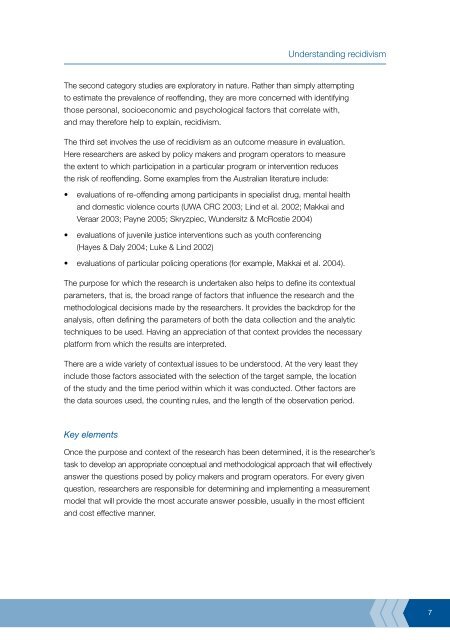Recidivism in Australia : findings and future research - Australian ...
Recidivism in Australia : findings and future research - Australian ...
Recidivism in Australia : findings and future research - Australian ...
You also want an ePaper? Increase the reach of your titles
YUMPU automatically turns print PDFs into web optimized ePapers that Google loves.
Underst<strong>and</strong><strong>in</strong>g recidivism<br />
The second category studies are exploratory <strong>in</strong> nature. Rather than simply attempt<strong>in</strong>g<br />
to estimate the prevalence of reoffend<strong>in</strong>g, they are more concerned with identify<strong>in</strong>g<br />
those personal, socioeconomic <strong>and</strong> psychological factors that correlate with,<br />
<strong>and</strong> may therefore help to expla<strong>in</strong>, recidivism.<br />
The third set <strong>in</strong>volves the use of recidivism as an outcome measure <strong>in</strong> evaluation.<br />
Here <strong>research</strong>ers are asked by policy makers <strong>and</strong> program operators to measure<br />
the extent to which participation <strong>in</strong> a particular program or <strong>in</strong>tervention reduces<br />
the risk of reoffend<strong>in</strong>g. Some examples from the <strong>Australia</strong>n literature <strong>in</strong>clude:<br />
•<br />
•<br />
•<br />
evaluations of re-offend<strong>in</strong>g among participants <strong>in</strong> specialist drug, mental health<br />
<strong>and</strong> domestic violence courts (UWA CRC 2003; L<strong>in</strong>d et al. 2002; Makkai <strong>and</strong><br />
Veraar 2003; Payne 2005; Skryzpiec, Wundersitz & McRostie 2004)<br />
evaluations of juvenile justice <strong>in</strong>terventions such as youth conferenc<strong>in</strong>g<br />
(Hayes & Daly 2004; Luke & L<strong>in</strong>d 2002)<br />
evaluations of particular polic<strong>in</strong>g operations (for example, Makkai et al. 2004).<br />
The purpose for which the <strong>research</strong> is undertaken also helps to def<strong>in</strong>e its contextual<br />
parameters, that is, the broad range of factors that <strong>in</strong>fluence the <strong>research</strong> <strong>and</strong> the<br />
methodological decisions made by the <strong>research</strong>ers. It provides the backdrop for the<br />
analysis, often def<strong>in</strong><strong>in</strong>g the parameters of both the data collection <strong>and</strong> the analytic<br />
techniques to be used. Hav<strong>in</strong>g an appreciation of that context provides the necessary<br />
platform from which the results are <strong>in</strong>terpreted.<br />
There are a wide variety of contextual issues to be understood. At the very least they<br />
<strong>in</strong>clude those factors associated with the selection of the target sample, the location<br />
of the study <strong>and</strong> the time period with<strong>in</strong> which it was conducted. Other factors are<br />
the data sources used, the count<strong>in</strong>g rules, <strong>and</strong> the length of the observation period.<br />
Key elements<br />
Once the purpose <strong>and</strong> context of the <strong>research</strong> has been determ<strong>in</strong>ed, it is the <strong>research</strong>er’s<br />
task to develop an appropriate conceptual <strong>and</strong> methodological approach that will effectively<br />
answer the questions posed by policy makers <strong>and</strong> program operators. For every given<br />
question, <strong>research</strong>ers are responsible for determ<strong>in</strong><strong>in</strong>g <strong>and</strong> implement<strong>in</strong>g a measurement<br />
model that will provide the most accurate answer possible, usually <strong>in</strong> the most efficient<br />
<strong>and</strong> cost effective manner.<br />
7















